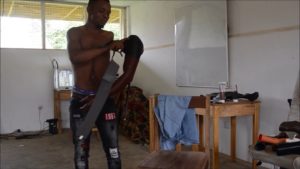Nowadays you can make just about anything with a 3D printer. Lars Brouwers, a doctor from Son en Breugel, knows that better than anyone.
Brouwers works with 3D printers every day in his job at Elisbaeth TweeSteden hospital in Tilburg. When his colleague was sent to Sierra Leone for a work project, Brouwers decided to go with him, and took his 3D printer along. With the printer, he gave people with disabilities new limbs and a new life.
Brouwers says that many amputees and people with disabilities in Sierra Leone are ‘ashamed’ because ‘they want to look normal’.
‘You can better explain to the patient’
Brouwers shows an example of the models that he prints in his surgical 3D lab. ‘This is a dilated artery,’ he says. ‘It is very difficult to see on a photo or a scan. With a 3D printed model, you can better explain to the patient what is happening in their body.’
The 3D models also help doctors. ‘Until recently, doctors could only prepare to perform surgery by looking at images from X-rays or CT scans. But now you have a three-dimensional model in front of you, you don’t have to worry about deciphering the scans anymore’.

Patients in Sierra Leone
Brouwers decided to join his doctor friend at Masanga Hospital in Sierra Leone as ‘I really wanted to help. And what can I do? 3D printing’. It was then that he had the idea to take his 3D printer with him.
The benefits the 3D printer could bring to doctors and patients in Sierra Leone were numerous, but Brouwers decided to focus on prosthetic limbs. Prosthetic limbs are in high demand in Sierra Leone. ‘Injuries are often treated by traditional doctors using leaves. But they can easily get infected this way, and then the only solution is amputation.’
Patients currently receive prosthetic limbs made of wood or metal. ‘They are quite functional, but they don’t look good. You can clearly see that they are artificial,’ Brouwers says.
Brouwers also noticed that disabled people are incredibly ashamed of their wood and metal prosthetics. ‘Disabled people do not participate in society there. They are on the edge. To be able to participate again, they must look normal.’
Self-confident
In collaboration with a team from a 3D lab at Radboud medical centre in Nijmegen, Brouwers now focuses on printing cosmetic prosthetics. A 3D scanner is used to make a replica of the healthy limb, which is then printed in mirror image. This gives the patient a prosthetic limb which resembles the healthy limb. Colouring is then used to give it the correct skin tone.
Thanks to this, ‘people are becoming self-confident again,’ Brouwers says. ‘Alex, one of our patients, was missing an arm. Now he can go back to college. He is back in the middle of society again.’

Photo credit: Lars Brouwers
Brouwers now wants to train people in Sierra Leone so that they can make their own prosthetic limbs in the future.
Source: Omroep Brabant
Translator: Rachael Vickerman
















